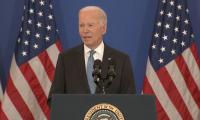ISLAMABAD: Debt servicing on both local and foreign loans is estimated to surpass two trillion rupees during the current fiscal year of 2018/19 compared with the annual target as monetary tightening was dubbed as one of the reasons of rise in cost of borrowing, sources said on Thursday.
The sources said the debt servicing, which has already become the largest ticket item on expenditures side, is all set to cross the two trillion rupees mark during the current fiscal year against the initial budgetary estimate of Rs1.6 trillion.
“The total debt servicing is going to consume Rs2 trillion during the current fiscal year owing to rising discount rates by 450 basis points that raised the debt servicing bill to the tune of Rs400 to 500 billion alone for the ongoing fiscal year,” a top official of the Finance Division confirmed with The News.
The State Bank of Pakistan (SBP) has raised its key policy rates by cumulative 450 basis points to 10.25 since January last year.
The sources said debt servicing is estimated to go up by Rs400 to Rs500 billion up to two trillion rupees against an earlier envisaged earmarked amount of Rs1.625 trillion for the current fiscal year. The revised budget estimates showed utilisation of Rs1.526 trillion during the last fiscal year ended on June 30, 2018 as against the initial estimate of Rs1.363 trillion.
Pakistan’s budget revolves around three Ds: debt servicing, defence and development. Now, the whopping debt servicing bill will alone outpace defence and development expenditures as a whole in 2018/19 ending on June 30, 2019.
Financing of budget deficit has also become another major problematic area where the short-term borrowing has absolutely replaced the long-term borrowings, leaving no space for the government to go back to long-term maturity papers.
Last government led by Pakistan Muslim League (Nawaz) adopted an opposite approach during the same period last year as it generated funds through long-term instead of short-term financing.
The existing situation shows an alarming trends as banks seem to be on the driving seat. They are in a position to dictate the government and the central bank on policy rates.
The challenging market dynamics made it difficult for the government to even refinance its existing medium to long-term maturities.
The government used SBP’s source to borrow Rs3.88 trillion till Feb 1 and it raised more than two trillion rupees through three- and six-month treasury bills (T-bills) on Feb 13.
No bids were, however, received for 12-month papers, indicating that banks were not interested in long-term treasury bills with banks expecting further rate hikes in months ahead.
The government met its financing requirements through short-term floating debt instruments, which helped it retire maturing Pakistan Investment Bonds (PIBs) as both offered and accepted amount in PIBs auctions fell short of the maturity and target set for the quarter. The government managed to meet most of its financing requirements from the external sources.
With ongoing expectations of monetary tightening, banks’ interest in PIBs auctions remained almost non-existent, while substantial amounts were offered in T-bills auctions at rate of 10.54 percent. Generally, the bidding pattern of market participants congregated towards short-term instruments.
Resultantly, the government was mostly able to generate funds via 3-month T-bills as participation for 6-month and 12-month T-bills also remained limited. Accordingly, share of 3- month T-bills in total T-bills portfolio reached around 98 percent till June-end last year compared with 40 percent a year ago.
The Regulus SoM chip, an AI Accelerator, sits on display during the Consumer Electronics Show in Las Vegas, Nevada,...
The HabiMetro Bank signboard can be seen in this image. — LCCI Website/FileKARACHI: HabibMetro Bank teamed up with...
An image of officials of ABHI Middle East Limited and UAE-based Al Ansari financial services. — Abhi AE...
This image shows Gojra Filling Station on Jhang Road Gojra Near M4 Interchange released on May 30, 2018. —...
The Competition Commission of Pakistan building can be seen in this image. — APP/FileKARACHI: The Competition...
People buying jewellery at a jewellery shop. — AFP/FileKARACHI: Gold prices decreased by Rs1,500 per tola on Monday...







